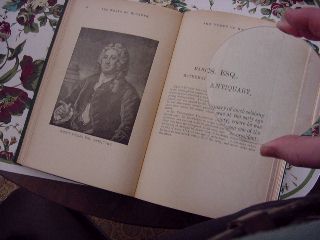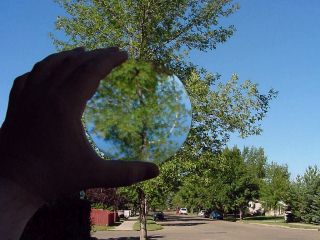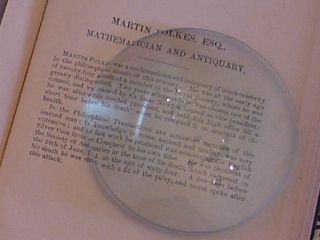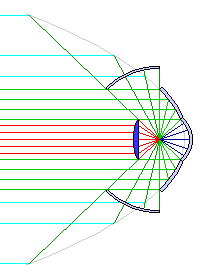
When you hold a magnifying glass a few inches away from a page of print, you can see the page enlarged.

Also, when you look at a distant object through the same magnifying glass, you see an upside-down image of the object in front of the lens.

A refracting astronomical telescope makes use of two lenses, one of which works in each of these ways.
The lens in the front of the telescope, called the objective lens, produces an upside-down image of the object one is using the telescope to look at.
The lens near the eye, called the eye lens, acts as an ordinary magnifying glass to magnify that upside-down image.
This is the basic principle of the telescope. Naturally, each of these two elements of the telescope could be made up of several lenses, to combat certain inherent limitations, or aberrations, of lenses with spherical surfaces made out of one kind of glass. However, before considering this, it is important to note that nearly all telescopes contain a third important element with a specific function.
In addition to magnifying or creating an upside-down image, a convex lens can do two other things. When reading a book, you have to hold the magnifying glass away from the page in order for it to magnify. If you set the lens right down on the page, it might as well be a flat piece of glass. (Actually, because of the thickness of the lens itself, it's always a small distance from the page, so it will magnify a little bit.)

If you gradually move further away from something with a magnifying glass, at first it gets magnified more and more, but the quality of the image quickly deteriorates. At a point between where the lens acts as a magnifier, and where it produces an upside-down image of what you are looking at, you will find the whole area of the lens filled with the colors of a very small area of the object you are examining.

When the lens is at this intermediate distance from an object, the object is at or near the focal point of the lens. This is not very useful for examining an object. But if you place the filament of a lamp at the focal point of a lens, then a lens so situated collimates the light from the lamp; rays of light radiating out from the filament are bent by the lens so that they are now moving in parallel, creating a useful beam of light. This is done, for example, inside movie projectors.
Still, we might well look upon this mode of operation as being useless, at least from the perspective of using lenses to look at things. The case of a magnifying glass sitting right on the page you are reading certainly could be called useless as well.
However, the third important element in a telescope is actually functioning in both of these "useless" modes at once, and yet it is performing a very important task.
When you look at a lens that is forming an upside-down image of a distant object, naturally the upside down image doesn't extend beyond the lens. After all, you are looking through the lens to see the object, so all the light from the object that you see has passed through the lens.
But if you move your head, and look at the lens from other angles, you can see that the lens is actually making a larger image than you can see from one place. The upside down image is located in front of the lens, even though the light that makes it up is seen through the lens.
How can you see the whole image?
One way is to put a piece of wax paper or ground glass in the plane on which the image is formed. That way, the light hitting it is diffused in all directions, and so you see some of the light from all the parts of the image.
But this is inefficient, as it doesn't direct all the light involved in a useful direction. And it limits the sharpness of the image, since things that diffuse light do so because of minute irregularities within them, as is obvious in the case of ground glass.
If you place a lens right in the position of the image, so that as far as the image is concerned, it is in the useless position of a magnifying glass lying on a page of print, that lens can, without changing the size of the image, bend the light that makes it up so that more of it goes towards your eye, or the eye lens in the telescope.
The way to make it do this the most effectively is to choose its thickness so that if you look through it to see the objective lens, you find the objective lens has been magnified so that it is everywhere you look. So the objective lens is being magnified by it into a large and blurry image, which is all right, because a telescope is not used to look at its lenses, but to look at things through them.
Thus, both "useless" modes of operation are involved in the function of this third element, the field lens.
A field lens is not essential for a telescope, but it makes the image you see through it brighter, and it improves the telescope's field of view, because with it one is no longer looking through a narrow tunnel defined by the size of the objective lens.

Astronomical telescopes may use a large mirror instead to perform the function performed by the objective lens.
The field lens and the eye lens are both contained in the telescope's eyepiece.
Of course, optics aren't just for imaging. Optical principles can also be used in such things as light fixtures. For example, here is an illustration of an old-style automobile headlight that, except for unavoidable real-world imperfections of physical objects, takes all the light from a point source, in every direction, and puts that light in a collimated beam:

The light from a point source can be collimated using a parabolic reflector; part of the mirror behind the point source follows the shape of the paraboloid, and more of it is shown by a dark gray line in the illustration.
A parabolic reflector, however, cannot help with the light which shines forwards from the point source. So, a lens is introduced which collimates that light.
Behind the lens, then, the parabolic reflector is now replaced by a spherical one, so that the light from the point source going directly to the back is reflected back onto the point source, from there to continue in the right direction to be collimated by the lens. Of course, the point source might be itself opaque, or for other reasons disturb the path of light passing through it, but in the real world this can be dealt with by displacing it slightly from the exact focus of the design.
Now we have a design that sends the light going in all directions from a point source into a collimated beam shining forwards. However, one more improvement is possible. Replacing the part of the parabolic reflector lying in front of the point source with a spherical reflector, so that again the light is reflected back on itself, avoids the need for a very large parabolic reflector, reducing the bulk of the assembly.
The lens shown in the diagram does have an unrealistically short focal length in proportion to its diameter. Shrinking the lens, and the spherical portion of the mirror behind it, results in the spherical mirror in front becoming larger; also, using a Fresnel lens allows a lens to be achieved with a fairly high proportion of diameter to focal length.
Copyright (c) 2001, 2004 John J. G. Savard